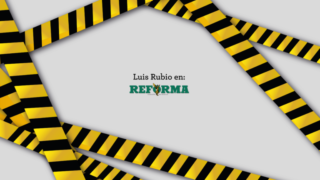Luis Rubio /Qrius
Luis Rubio escribe sobre los retos de México en 2018: inestabilidad política, un sistema de tres partidos y la tendencia de políticas económicas de izquierda
Mexico is currently going through three simultaneous social shifts that feedback into each other and may change the face of the country. First of all, it is undergoing a lengthy economic, political, and demographic transition. Second, the country is experiencing a difficult relationship with the US, its main business partner and, through NAFTA, Mexico’s principal source of stable trade. Finally, a presidential race is underway, which will take place July 1. All this is occurring in a context of unusual physical and political violence and great anger among the electorate.
Political instability as Mexico democratises
Mexico’s ongoing and drawn-out transition to democracy has often been compared with Spain’s, but the differences are vast. Spain began to change after the death of a dictator and with the support of its European neighbours while, in the case of Mexico, the change was never about a person but rather about a political regime personified by the PRI. This political movement created a system of political control that has exhibited an extraordinary capacity for adapting to the times, which is why it never disappeared.
In this way, Mexicans have experienced a process of political change that has been largely reactive in nature and with no clear aim in view. In consequence, despite significant advances, elements of the old political system continue to remain entrenched. Instead of opening the system to true competition, the opposition parties, PAN and PRD, were incorporated into the old system of privilege. All of this creates an environment of conflict, especially with regard to economic policy.
A three party system
The electoral scene in the country is dominated by three people. First is Andrés Manuel López Obrador (called AMLO) who, in his third attempt to win the presidency, is running ahead of his opponents. José-Antonio Meade, the candidate for the PRI, is distinguished by his successful experience as a public servant under two governments of different political parties, but his primary characteristic is not having being a longterm member of the PRI; the party put him forward in order to distance themselves for their unpopular current president, Peña-Nieto. Finally, Ricardo Anaya, the candidate of the so-called Frente or Front—which groups together the more conservative PAN, PRD, and MC—has begun his campaign with a progressive approach that has moved the party little by little toward a rhetorical position not so different from that of AMLO.
To these three candidates, one may add two or three independents who, although without any chance of winning, could exert an important effect on the outcome by drawing votes away from the main presidential aspirants. It is still too early to be able to anticipate the result because, given that there is no run-off in the Mexican system, the weight of the party machines to get out the vote can be determinant as the country enters the last five months before voting day.
The rise of left-wing economics
Disagreements with respect to whether the Mexican economy should be an open one or should move more towards autarky, lie at the heart of the presidential race. In the eighties, Mexico opted to liberalise its economy and join various commercial alliance around the world, which led to the country’s accession to NAFTA. An offshoot of the PRI party has rejected those reforms and continues to do so as the Morena party.
All of these strains have been exacerbated by Trump’s threats to cancel NAFTA, which is the main engine of the economy and a crucial stabilising factor in promoting the Rule of Law in Mexico. Thus, Mexico is going through a unique and very sensitive moment that, with or without NAFTA, would obligate it to deal with international uncertainty by establishing stability at home. However, a huge challenge for Mexico’s system of government is that it endows the winner with enormous, even excessive powers, which does not help in overcoming the country’s internal conflicts.
La reproducción total de este contenido no está permitida sin autorización previa de CIDAC. Para su reproducción parcial se requiere agregar el link a la publicación en cidac.org. Todas las imágenes, gráficos y videos pueden retomarse con el crédito correspondiente, sin modificaciones y con un link a la publicación original en cidac.org




